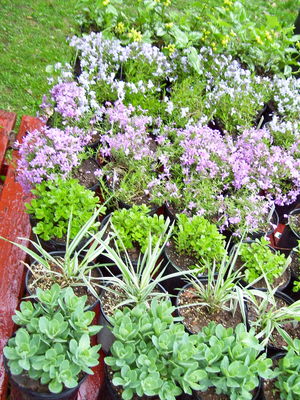Obtaining perennials can be expensive in a slow economy. How to go about obtaining free plants from these seven sources of free perennials.
Source #1 for free perennials, undiscovered free backyard treasures: This source is a good source for people new to gardening to consider. Many times, plants will escape from an old garden and naturalize themselves in the yard. If you have a friend or relative who knows plants well, have him or her visit and take a look at all the plants that have potential. If you are lucky, you may even discover an abandoned flower garden with a lot of surviving perennials still growing in it. If you have just purchased a home and it is winter, you may find some pleasant surprises growing in spring.
Source #2 for free perennials, division: Take inventory of any existing perennials growing in the garden and try to identify what they are. Then you can research when and how to best divide the plants. Not only does dividing perennials provide free perennials, it also provides “bargaining chips” you can use for acquiring new perennial varieties via trading with other gardeners, provided the perennial you are dividing is a desirable cultivar.
Source #3 for free perennials, roadside plants: Occasionally, you can pull off a roadside swipe of a desirable plant. Make sure that the area you take the plant from is not someone’s yard or garden, nor an area that looks cared for or cultivated. Free garden plants you can find escaped along the roadside include Orange Daylily, Vinca Minor, Standing Phlox, Pachysandra, and occasionally mint.
Source #4 for free perennials, dumps: It is not uncommon for gardeners and homeowners to dump organic garden waste in the woods and I have lifted some really good free perennial plants from the dump. Of course, the plants were in very sorry shape at the time of the salvage, but with some good gardening care, almost any perennial should come back. Some of my finds include a whole clump of bearded Iris that rooted where it was dumped, five sedum plants thrown over a cliff in the woods along the paper route, three hundred iris rhizomes ditched by my boss, and a huge clump of Zagreb Coreopsis that had been ditched in the woods across the street that had already lost its foliage. I planted the coreopsis in the garden and it has since doubled in size.
Source #5 for free perennials, the waver wire: This one is about being in the right place at the right time. A lot of gardeners hate killing plants but find their perennial plants have spread and have to scramble to find places to plant the plants. Many times, they will give away extra plants for free rather then see the plants go to waste or have to find a place to plant them.
Source #6 for free perennials, friends and relatives: Most garden and plant enthusiasts find it very easy to talk plants with anyone. Several times, I have received offers for a free division of a specific perennial that I had admired during the conversation. Friends and relatives usually won’t hesitate to donate extra plant divisions of plants to you for free. In most cases, you are solving a problem for them if their plant has spread too far.
Source #7 for free perennials; trading: This method is better than method #6, although it requires you to already possess a reliable or desired variety of perennial. You see a coveted perennial and offer to trade one of your perennials for a piece of the coveted perennial. There are two distinct benefits to trading. First, you don’t feel like you are begging, and second, you can pry a piece of a more valued perennial with it if your bait is good enough as opposed to receiving the free scraps of common or weedy perennials.
These methods of acquiring free perennial plants should provide you with enough perennials to get your flowerbed off to a good start. Of course, you can always obtain more when the money comes in.
Reference:
- How to divide Irises: www.associatedcontent.com/article/859701/how_to_divide_your_irises.html?cat=32




